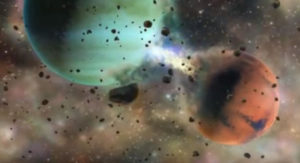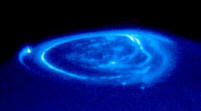


Rough Notes:
Credit: NASA/CXC/SAO
May 12, 2006
A, B, C, D, Electric Solar System
NASA investigators now recognize that Jupiter's auroras are electrical phenomena. But they are struggling to understand the electrical connections of the aurora's "tails" to other bodies in the Jovian system—not just to Jupiter's closest moon Io, but also to its second moon Europa.
For almost two years now, we have been making the case in these pages that the "volcanic"plumes on Jupiter's moon Io are plasma discharge arcs from the moon's electrical transactions with the gas giant. In recent years a growing number of scientists have acknowledged the electrical exchange between the two bodies, as confirmed by Io's "footprint" in the Jovian aurora above.
But now a new study reports that one of the bright spots in this aurora is the footprint of a continuous electrical exchange between Jupiter and another moon, Europa. In October of 2005, the journal Geophysical Research Letters published a report from a research team headed by Denis Grodent of the University of Liège, Belgium, noting the team's discovery of a short auroral tail linking Jupiter to Europa. The report notes that this footprint is similar to that of Io, but less energetic. Grodent's team based its report on a study of 45 Hubble images of the Jovian aurora showing Europa's footprint and its swirling "tail".
In previous attempts to explain the electrical connection of Io to Jupiter, astronomers suggested that Jupiter's tidal influence on Io provoked the release of the observed charged particles in Io''s "volcanic" plumes. The particles then flowed as an electric current to Jupiter, as evidenced by the glowing electrical signature (footprint) in the gas giant's aurora. But in electrical terms this supposed one way transaction could not be valid, and it left Europa dangling in "neutral" space. How would its electric connection to Jupiter be explained?
"…Europa is not thought to be volcanic, so what could produce the electrical current that zips along and eventually gives rise to Europa's auroral footprint?" the writers of the report ask.
Here we meet an old dilemma once again. Standard astronomy begins its investigations with the assumption--usually unspoken—of an electrically neutral universe. So when investigators encounter electrical phenomena, they rely upon local "generators" no matter how improbable. And they will ignore the evidence for larger electric circuits that have, in fact, already answered the question posed: the local transactions involve circuits, not one-way paths. And the local circuits are subsidiaries of larger circuits.
In the case of Jupiter, the larger circuit is that between the gas giant and the Sun. In the case of the Sun, the larger circuit connects the Sun to a spiraling arm of the Milky Way. And there is evidence aplenty that galaxies themselves are joined in still larger electrical exchange. Where the hierarchy ends, no one can say. But that it exists is substantiated by every line of investigation that has been opened up in recent decades. There are no isolated islands in space: All objects in space are connected in a web of cosmic circuitry.
An electrical interaction between Jupiter and its moons means that the bodies are charged. (As soon as you grant that one body is charged, the other body is also charged in relationship to it). Jupiter is not an island. It stands in a dynamic electrical relationship to the Sun, just as does the Earth. It is now known that charged particles from the Sun, not a terrestrial "dynamo", power Earth's auroras. The same thing can be said of Jupiter's auroras, though this was as contrary to astronomers' assumptions as was the confirmation of the Sun's input to terrestrial auroras. Work by scientists at the University of Leicester in the UK found “a strong correlation between the strength of the solar wind and the behaviour of [Jupiter’s] auroras". But this was "completely the opposite result to the one we were expecting from our predictions".
Of course, what is surprising or illogical from one vantage point may be "reasoning from the obvious" in another.
A: Jupiter interacts electrically with its moons.
B: Jupiter interacts electrically with the Sun, as does the Earth.
C: The planets in the Solar System are charged bodies.
D: The sun has an electric field.
Suddenly the elephant so long "hidden" in the living room of astrophysics is exposed. Since the sun gives off proton storms, and the protons in the solar wind are being accelerated away from the sun, it should have been obvious all along that the Sun is the center of an electric field…
- E.Electrical transactions between the Sun, the planets, and the planets' moons are only to be expected in the Electric Universe.
Electrical connectivity is thus confirmed by every level of investigation; it is not just the reason for Io's "volcanic" plumes; it is the reason why Saturn's moon Enceladus similarly spews out icy particles in high energy jets; it is why Europa and other moon of Jupiter and Saturn and Uranus display vast networks of channels that can only be explained as electric discharge scars; it is why the planets have teardrop shaped Langmuir sheaths; it is why Mars, moving on an orbit more elliptical than Earth's, is periodically overtaken by globaldust storms and Everest-sized "dust devils"; it is why the Earth discharges to space throughsprites and elves; it is why remote comets discharge so brilliantly as they approach the inner solar system; it is why "asteroids" can become comets if their orbits are sufficiently eccentric; it is why comets sometimes break up as they move through the Sun's electric field.
Once admitted, the Electric Universe will not just alter a few imagined "islands" in space; it will change the picture entirely.
Thanks to Michael Armstrong for the primary scientific content in this article.